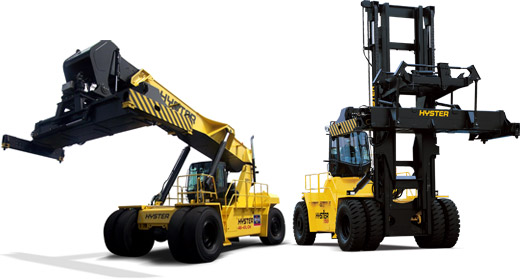How to choose between a Reach Stacker and a Dedicated Container Handler

Will a Reach Stacker or dedicated Container Handler work best in your operation? It can be tricky to decide, as both offer various benefits. In many cases, reach stackers enable increased container storage, but increased storage density can affect the accessibility or ‘selectivity’ of containers, which could then result in extra handling and reduced throughput of containers. Therefore, the key to making the right decision is to identify the specific application requirements and consider which equipment can best meet the demands of the operation. This is where an experienced supplier such as Adaptalift Hyster can help.
When assessing whether a reach stacker or dedicated container handler would best suit your operation, it’s important to review both types of machinery in terms of four main attributes: Storage, Selectivity, Capacity and Load Centre, and Manoeuvrability.
Storage
For locations which have limited available space, mobile handling equipment that enables the highest density, may be required. Increased density is achieved by stacking higher as well as deeper. A container handler, for example, may stack up to 4 high (Hyster machines can stack up to 5 high standard and 6 high (SPED)) but only 1 row deep, however the terminal will be laid out for maximum handling speeds of containers with good traffic flow. Alternatively, to increase the amount of containers per square meter, reach stackers can stack up to 4 high in the 3rd row and 5 in the 1st (due to demand Hyster has a 6 high reach stacker). Normal practice for good circulation and to speed up the handling is to have 2 rows in a ‘pyramid’ shape, 4 high 2nd row and 3 high 1st. Here, the selectivity of containers should be considered.
Selectivity
Selectivity refers to the number of containers that are on top or in front of a particular container, which have to be moved in order to access the container in question, and must then be restacked. The aim is to limit “dead picks”. This ‘selectivity’ has a major effect on the speed of the container handling operation, with regard to the handling time required to transfer a specific container. In a port environment, for example, changes to loading or unloading times can be a regular occurrence and despite the use of sophisticated logistical systems to coordinate the task, some restacking of containers seems to be unavoidable. The speed of the restacking depends on the level of selectivity offered by the handling equipment and, in this instance; the container handler would be the better choice, as it offers greater overall selectivity.
Capacity and Load Centre
For forklift manufacturers, model designation usually refers to a nominal capacity rating at a 1.2m load centre. However, for container handling, this is greater due to the additional reach and rotation required and should be around 1.6m. Reach Stackers are available with various lift capacities, with most manufacturers specifying capacities in the 2nd container row at around 3.85m load centre (taken from front axle). In practice however, this leaves as little as 0.14m clearance between machine and container which would slow the operation. So a practical load centre for 2nd row stacking is more appropriate at 4.25m which can reduce lift capacity, but it is an important factor that should not be overlooked. This capacity restriction may well disrupt an intended double row container stacking operation or increase the amount of digging/dead picks. Therefore, selecting reach stackers with sufficient 2nd and even 3rd row lifting capacity is vital. Hyster for example has reach stacker models that offer 46t in the first row with up to 30t in the third.
Manoeuvrability
Both container handlers and reach stackers commonly operate in 15m wide aisles, stacking a mix of 20’ and 40’ loaded containers. However where additional capacity is required to stack heavier containers or higher in the second row, the standard reach stacker may not offer sufficient lifting capacity. In this case, a larger machine will be needed that may be up to 9m in length (as opposed to 8m), increasing the aisle width requirement.
In conclusion, the challenge for a terminal operator is to establish what is a workable mix of the key variables that is required and let this determine the choice of handling equipment. Investment in reach stackers may increase the terminal’s storage, while container handlers may well be faster. Working with an experienced supplier like Adaptalift is highly recommended and will help with the decision making process, ensuring the right machine for the right operation.